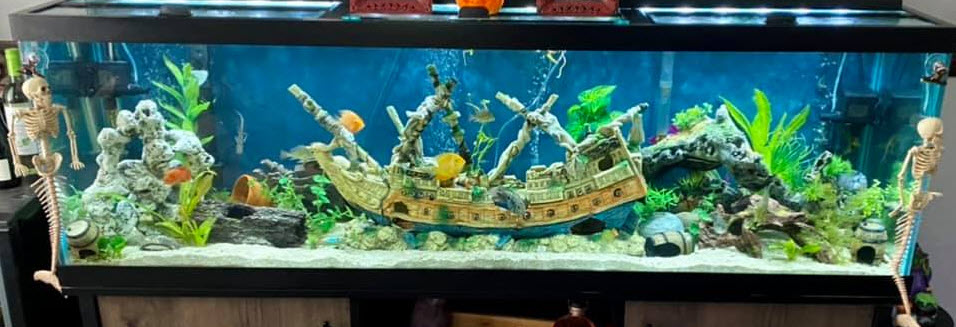
Aquaponic filtration uses plants to remove nitrates from the water. It is very misunderstood. Each small fish needs a lot of rapidly growing plant tissue to adequately remove the nitrates the fish puts out. A moderately stocked aquarium will NOT be adequately bio filtered by one pothos plant on top of the aquarium.
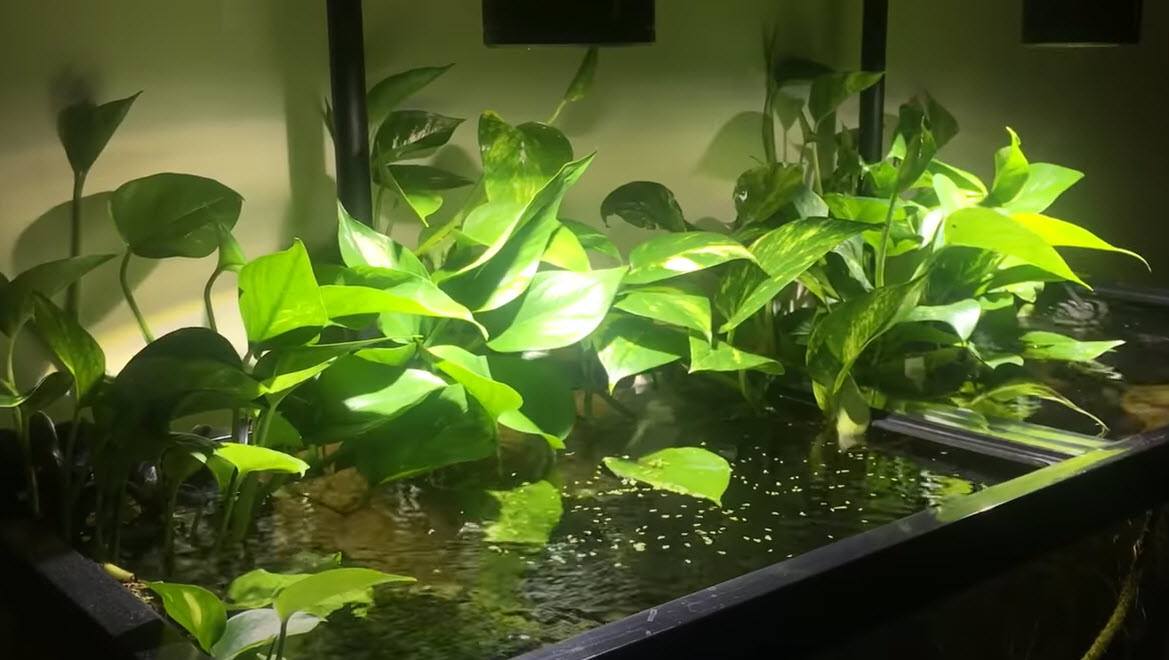
The Basic “Rule”
.
Plants will work for filtration ONLY when there is a huge amount of plants for a small amount of fish.
.
I have never seen anyone successfully violate this rule. NEVER!
My Aquaponic Setup
I have used aquaponic (hydroponic) filtration very successfully many years ago. I had my main aquariums in the house. I drained the water from the aquariums through the crawl space of the house to a large rectangular tub (four feet by three feet in size) on the floor in the garage. The tub had six inches of 1/8th inch aquarium gravel under about three inches of water.
There were several under-gravel filters with powerheads in the tub. The powerhead on one of the tub’s under-gravel filter lifts moved the water back to the aquariums in a very slow flow (it was 6 feet uphill). I returned the water to the garage by two redundant overflow double siphons in each aquarium. Plans for these can be found at:
14.7. Overflow Devices
I had two sets of two 3-foot fluorescent grow tubes over the tub and put Amazon frogbit, water lettuce, Salvinia, Azolla, and duckweed into the tub. In my water chemistry the duckweed soon took over, it just grew amazingly fast. I’ve corresponded with some hobbyists that have also used a combination of plant species. They all had different species of plants “take over”. Every species of plant responds differently to the lighting and water chemistry involved.
I was amazed at how often I could pull handfuls of duckweed from the tub (once a week!). When I removed these plants and disposed of them, I was removing nitrates and phosphates from the aquarium. The under-gravel filter in the aquaponic tub did a great job keeping nitrites and ammonia out of the aquarium. I never did water changes and rarely cleaned algae. Note that for roughly half a pound of fish (220 grams) I had about 12 square feet of growing surface.
Note that I have not repeated this setup. A continuous drip water change system is cheaper to set up, cheaper run, easier to set up, easier to run, and doesn’t take up space in the garage. But I found it interesting to do. And there are two situations where this aquaponic setup will be useful. One is where water is really expensive. The other is where the water supply has very high nitrates or phosphates.

Other Aquaponic Designs
Some build very complicated sumps with small areas that have light and some plants. These designs are not productive. They simply have too little area of plants to do any good. Here is such a design:
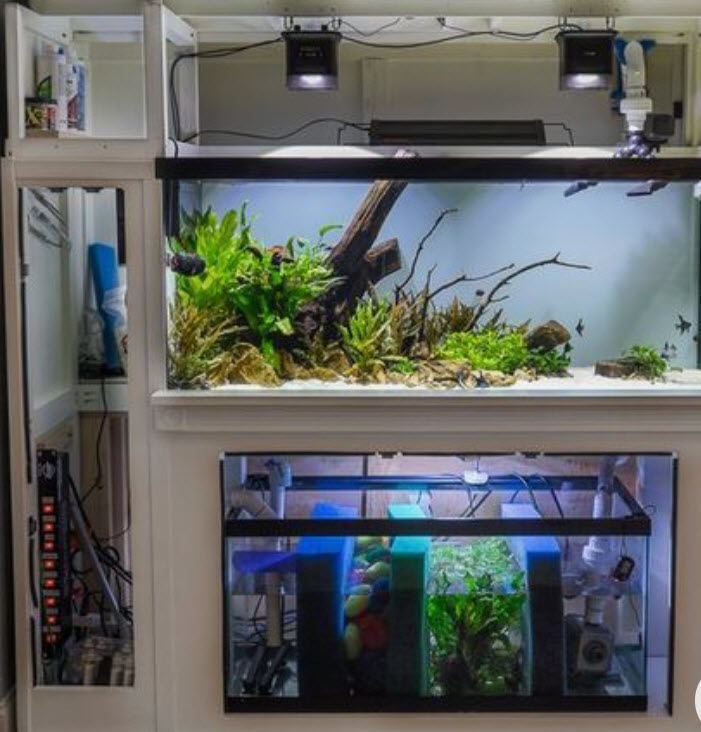
There are some “refugium” sold commercially which have about one quarter square foot of growing surface. These are just too small to be of use for reasonably stocked freshwater aquariums. And note that research has shown plants are not linear in productivity with the amount of light. At high light conditions, like full sunlight, most plants can’t pull in enough carbon dioxide for photosynthesis and they just metabolize at the same rate they did at half sunlight levels. The refugium is also very expensive and they require a sump filter.
“Half-man-half-cichlid” on YouTube has some very well-lit refugium DIY designs for sumps. His refugiums are of the “algae scrubber” type. And the King of DIY, Joey, has some cheap do-it-yourself designs in aquarium refugium which are “algae scrubbers”. These “algae scrubbers” need at least 15 watts of crimson/blue LED grow lights on them and need constant upkeep and algae removal. These designs all have very small areas exposed to light. They are not worth it in my opinion.

A comment from BrentL is appropriate here:
“I have a Clearwater Algae Scrubber CW100 (outgoing model), which has a screen size of 7″x6.75″. The LED lights have 40 watts (I believe that’s for both sides), although my wattage meter only shows 15 watts in actual operation. Each side has maybe a dozen or so lights, mostly red with a few blue. The lights are on 20 hours a day; pump is on 24 hours.
Side note (for those reading & interested): The algae scrubber does not work as great in freshwater as it does in saltwater. 99% of youtube videos and online articles show how effective algae scrubbers are in the saltwater setting, where it can bring nitrate to zero and possibly replace protein skimmer. That is not the case in the freshwater setup. First, the type of algae grown is completely different. Saltwater grows thick thatch of light green algae, which filters nutrients much more effectively. Freshwater grows very fine, hair-size, short (<1/2 inch), dark green algae that never grows thick. With medium stocking and medium feeding, I was able to somehow control nitrate at around 20ppm – 40ppm. Eventually I had to do water changes. What it does help is keep the interior of tank very clean. In conjunction of keeping LED lighting low and a few Panda Garras, I only need to clean the inside of glass or tank decors once every couple of months. But then I have to clean the scrubber (the screen and the housing) once every two weeks or sooner. For those prefer a “natural look” of aquarium with algae, then the scrubber may not worth the hassle…(and the price!)”
Half Man/Half Cichlid has now gone over quite successfully to using emergent water sprite to reduce his nitrates. He pulls two handfuls of water sprite out of his aquarium per week, controlling the nitrates quite well. Here is a photo of his water sprite:
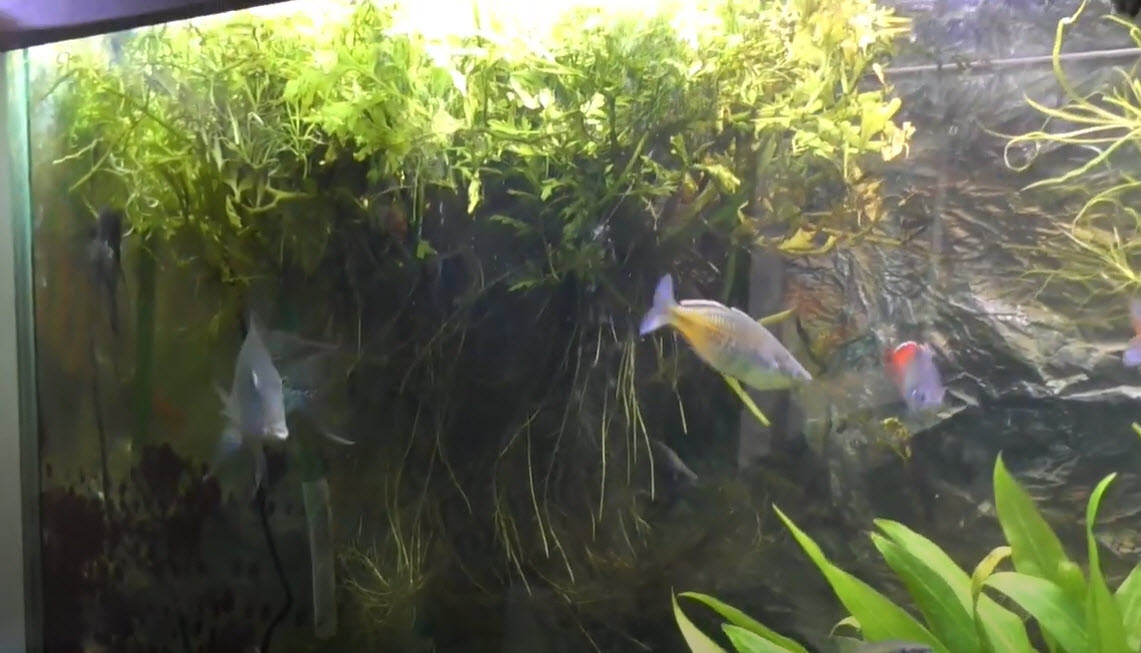
But for some purposes, an aquarium can be set up as a simple aquaponics setup. After cycling the filter lightly stock the aquarium with small fish. Just set up the aquarium with grow lights suspended over the tank and put in some of the various plants mentioned below. The plants will remove the waste from the fish when handfuls are taken out of the aquarium.
Alternatively, one can simply grow emergent arum tropical rainforest plants like Syngonium, pothos, monstera, philodendron, Chinese evergreen, and spathiphyllum (Peace Lily) and put the aquarium in a well-lit window. Then just let the plant grow rampant. Note there are a lot of YouTube videos on how to do this. Arums are extremely efficient users of light in low light conditions.
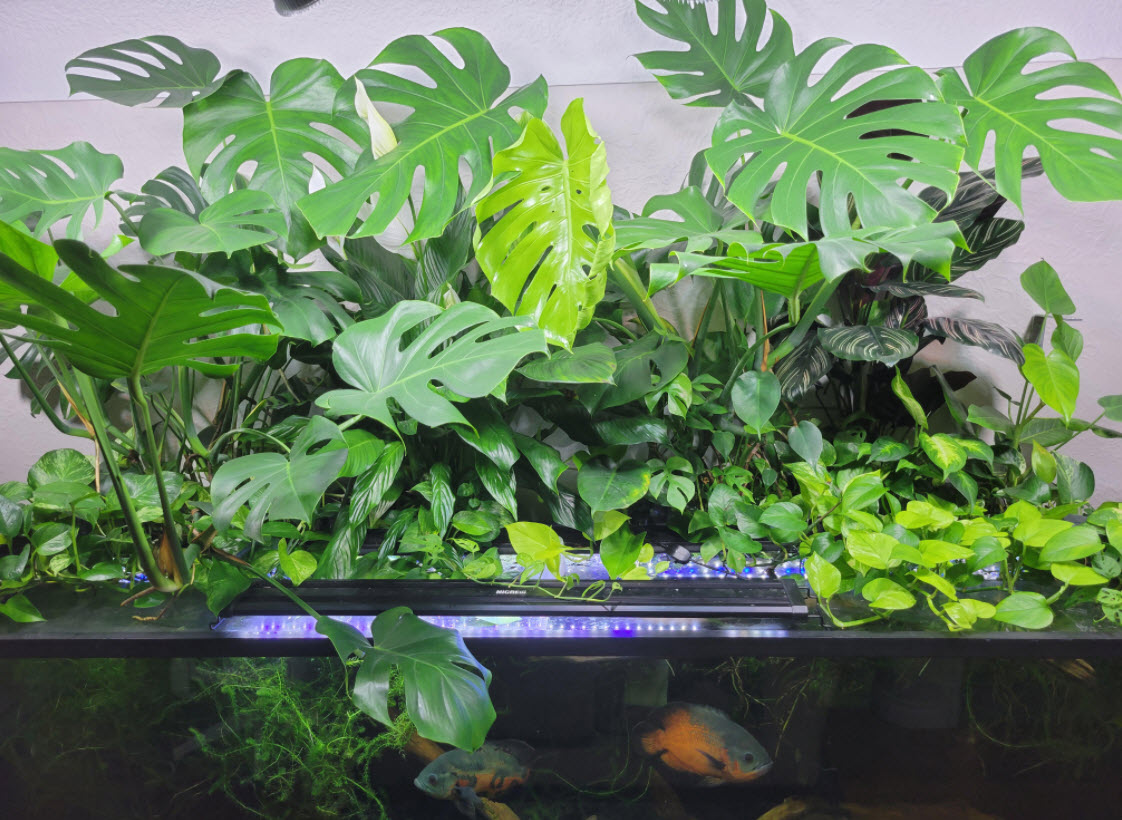
Plants for Aquaponics
The ability of plants to absorb nitrate is very dependent on whether or not the plant leaves are exposed to air versus being submerged. For the light intensity of a typical high powered LED light twelve inches from the plants have the following kilogram dry weight per square meter per year of production:
- Emergent plants like Azolla, duckweed, and water lettuce 2.5
- Tropical rain forest arums like peace lily, pothos, monstera, 1.7
- Terrestrials like herbs, and vegetables, 1.0 (note they will rather rapidly die in most aquaponic setups)
- Submerged plants like Vallisneria, elodea, swords 0.6
Submerged aquatic plants such as Vallisneria, elodea, swords, and algae only have roughly 23% of the nitrate removal potential of surface water plants (water lettuce, Amazon frogbit, Salvinia, Azolla, and duckweed). Annual emergent plants such as vegetables only have roughly 50% of the nitrate removal potential of surface water plants.
Emergent tropical rain forest arums such as Syngonium, pothos, monstera, philodendron, Chinese evergreen, and spathiphyllum (Peace Lily) have about 75% of the nitrate removal potential as surface water plants when they are grown with their roots in the aquarium water. Note that arums grown in water over 7.5 pH need a tiny smidgen of iron sulfate (ferrous sulfate) added once or twice a week to the water. If they do not get the iron they will turn yellow and fail to thrive.
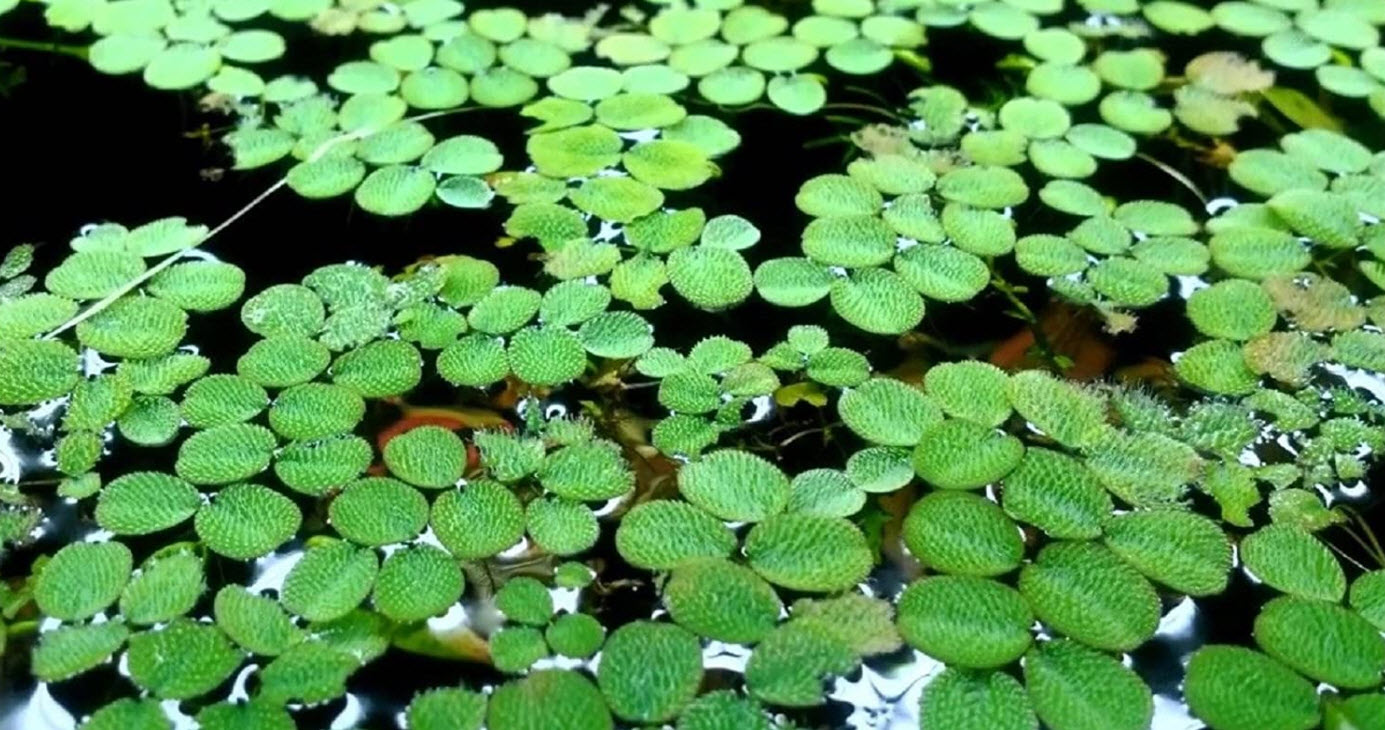
If one is serious about removing nitrates and phosphates the best plants for doing that are a combination of water lettuce, Salvinia, Azolla, and duckweed. These emergent plants can grow amazingly fast in the right situation.
Their productivity is 2.5 dry weight in kilograms per square meter per year if grown with high-powered LED lights 12 inches from the plants. This is 15% (15% of proteins is nitrogen typically) of 60% (very green plants are a surprising 60% protein) or 0.09 x 2.5 or 0.225 kilogram or 225 grams of nitrogen per square meter per year. That in turn is (225)/(12 months x 10.8 square feet per square meter) = 1.7 grams per month of nitrogen removal per square foot. 1.7 grams/(15% nitrogen in protein x 40% protein in fish food) = 29 grams of food per month, 1 gram of food per day. Or 1/.015 = 67 grams of fish for every square foot. It works out to, a per square foot of floating plants:
- 22 one inch fish
- 5 two-inch fish
- 3 three-inch fish
- 2 four-inch fish
- 1 five-inch fish
On a per square foot basis that is a decent number of fish. A 20-gallon length is 2.5 square feet. That is seven three-inch fish, i.e. light stocking. But note this ONLY applies to floating plants growing under intense LED grow lights, with a good flow of air over them. The setup above where I used florescent tubes had only about one-fourth of this carrying capacity.
Note that virtually all rainforest arums have things like oxalate in them to repel things like fish. Fish will nibble on a root. They spit the bad-tasting stuff out and then leave the plant completely alone. So these plants DO NOT poison fish. Unfortunately, domesticated cats aren’t that smart. Cats will eat arums and make themselves sick. Typically it is not fatal but they keep doing it (cats are NOT that bright!)

Note I do not recommend sweet potato. The sweet potato tuber is a big piece of organic food, largely carbohydrates. This tuber can slowly decompose and put a real strain on the filter of an aquarium. If it doesn’t decompose, the roots the plant puts out will soon fill the aquarium.
This difference in efficiency for submerged versus emergent plants is due to the ease with which the plant can get carbon dioxide. The carbon dioxide concentration in the air is about 400 parts per million. The carbon dioxide concentration in water is normally about 2-4 parts per million.
Note some individuals try to grow things like vegetables and herbs on or in the gravel on top of the aquarium. The water dribbles over the rocks and supposedly grows plants. This is nice in principle but simply doesn’t work. Commercial vegetables grown in water by hydroponic growing are generally flooded then drained, flooded then drained on a schedule. Constant water and they do not do too well. Most “rainforest plants” are from a family called “arums” (“Araceae” family) and can live with their roots in water 24/7. Vegetables and herbs won’t do this.

Light for Aquaponics
Note that hydroponic filtration requires a large surface area depending on the light source. Fluorescent tubes require about ten square feet of exposed plant surface per pound of fish. High-intensity LED light sources to require only three square feet per pound of fish. Full sunlight, even though it is easily three times more powerful than LEDs, requires three square feet per pound of fish because of carbon dioxide limitations.
The distance from the plants to a light source is important. A light source one foot from the plants is two to six times more effective than a light source two feet from the plants (it depends a lot on how the light is designed). But note that bubbles from an air stone create a mist or aerosol. This aerosol will take out an LED light in very short order. So do not mix air stones and LED lights that are close to the water.
The LED grow lights they have now can put out a lot of light and can grow an amazing amount of plants and absorb a lot of nitrate and phosphorus. It is important to use some of the crimson and blue LEDs. The white LEDs are great for looks but don’t grow plants all that well at low light densities. But note this is somewhat intensity dependent. At higher light densities there are orange and red pigments that absorb yellow-green light and donate electrons to chlorophyll. At very high light densities the whole process is inhibited by the availability of carbon dioxide.
And a small fan moving air over the plants is important. Plant leaves need access to lots of air to get the carbon dioxide they need. I would try a variety of plants. Duckweed took over in my tanks but some hobbyists have had Azolla take over and some have had Salvinia take over. Water lettuce can also work very well. The “prettiest” is probably Amazon frogbit but I find it to be tricky.
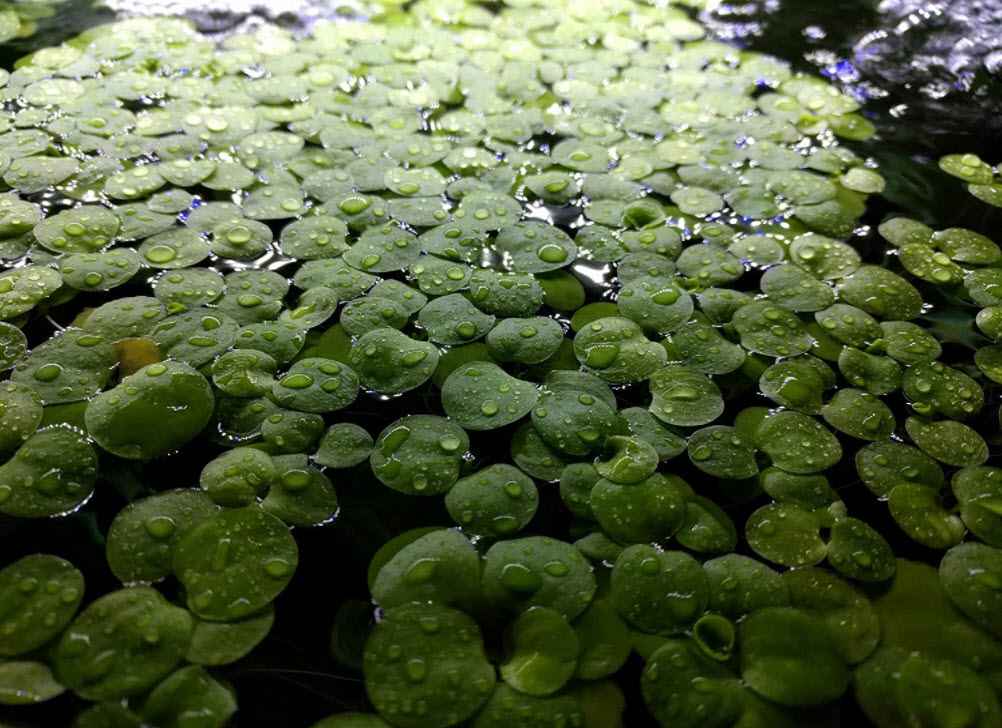
The Math Behind Aquaponics
I get a kick out of set-ups that have a single pothos with about five leaves on it growing out of a hang-on-back filter. The math of hydroponics is simple. A moderately stocked 100-gallon aquarium will have 150 grams of fish in it. These fish will require 1.5 grams of dry food per day. The plants such as pothos are at least 90% water. This says one needs ten times more weight of leaves/roots than food.
So the plants need to grow at least 15 grams of new foliage and roots per day to keep up with the food being put in the aquarium. Since one pothos leaf is about 2 grams of weight this is roughly eight new leaves per day, 56 new leaves per week, and 240 new leaves per month. If a single pothos puts on two new leaves per month, it’s growing rapidly. Whoops! Of course, the roots and stems also grow and absorb nutrients but it is still not a lot.
And the situation gets worse according to the great researcher Diana Walstad (Her book “Ecology of the Planted Aquarium” is a must-read for any planted aquarium enthusiast). Using Ms. Walstad’s plants nitrogen concentration (Table VII-2) it’s 27.5 g of new plant tissue per 1.5 g of 42% protein food (1.5 grams food x 0.42 protein in food x 0.17 nitrogen in protein / (1-0.9)/0.039 = 27.5g).
Using something called the “critical nitrogen concentration”, it is 67g (nitrogen-limited plant)(1.5g x 0.42 x 0.17 / (1-0.9)/0.016= 67g). I.e. per Ms. Walstad, it is twenty (actually 18.33) to forty times (actually 44.67) more weight of leaves/roots than food. This is two to four times what I calculated. Note I’ve tried to understand Ms. Walstad’s analysis here and it just doesn’t make much sense to me. But I am getting to the age where complex problems often become unsolvable. Ms. Walstad is rarely wrong so I’ll go with her analysis.

If one uses their imagination there are many different aquaponic setups possible. In-aquarium aquaponics is just a planted aquarium. A LED grows light (blue and crimson LEDs) set up in a sump in the garage or basement can be very effective. Not that one doesn’t need to turn over the water in the aquaponics set-up but about once a week. So temperature isn’t much of a concern. One can even use an outdoor plastic mini-pond to do the water cleaning. The thing to remember is that a lot of plant poundage is required to service just a small number of grams of fish.
.
Return to Filtration Menu
.
Aquarium Science Website
The chapters shown below or on the right side in maroon lead to close to 400 articles on all aspects of keeping a freshwater aquarium. These articles have NO links to profit-making sites and are thus unbiased in their recommendations, unlike all the for-profit sites you will find with Google. Bookmark and browse!
.

Dave says
In reply to Loi ….. Plants will work for filtration ONLY when there is a huge amount of plants for a small amount of fish.
Loi Nguyen says
Hi, will the surface area created by the plants be enough for dealing with free floating bacteria? Or this type of filtration should only be an additional instead of the main one?
Dave says
In reply to Jeremy …. I think continuous drip is ALWAYS better than batch. You just need to throttle the drip way down as your water isn’t cheap (even with the exchange rate at 0.67).
Jeremy R says
Hi, I Iove the math approach.
I’m wondering, I pay $2.40 AUD for 1kL of water. Im not sure if it’s with doing a continuous drip and overflow, or if pumping out 20%, then pumping in 20% is better. Tank is 1600L.
Definitely not worth while running grow lights in my garage I don’t think. Average cost of electricity is about $0.40 kWhr.
If you were to pump water outside to a pond, of sorts, do you need substrate for azolla? I have a lot of it growing in a tub. Didn’t know if I need 6 inches of it though!